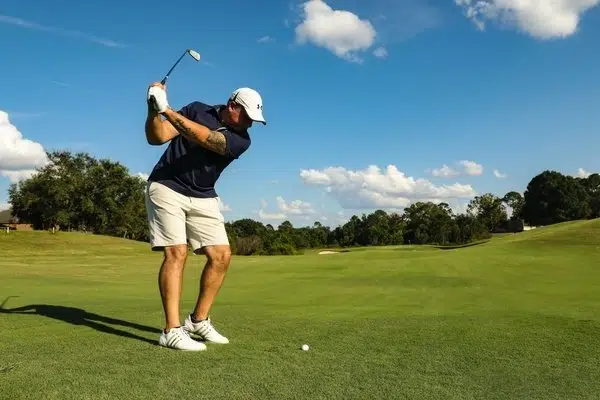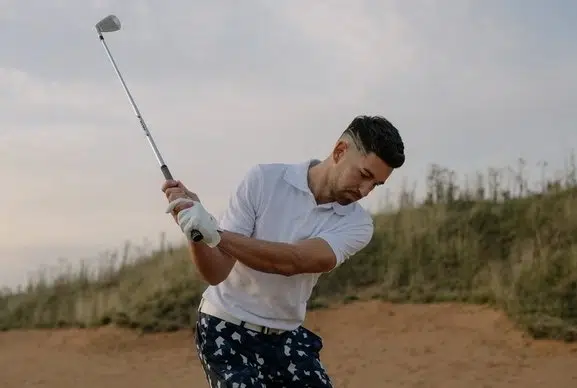It’s undeniably fascinating watching how different people swing the club, and one of my great interests every time I play with someone new is observing how they approach playing a golf shot.
Even some of the world’s best, take Matthew Wolff for example, take the club away in bizarre ways, with Wolff lifting the clubhead straight up into a remarkably upright position.
However, one thing just about every high-quality golfer is able to do is ensure the club begins the downswing on a shallow, inside trajectory, getting the club on plane the majority of the time.
This is why, no matter how you get the club to the top of your swing, the downswing and transition from the top is so crucial.
Yes, the perfect takeaway and backswing will help make it easier to transition into a good downswing, but as long as you get into the right position at the top, you can still make good swings, even if your journey to get there was somewhat unconventional.
To make sure you transition to the downswing in the best manner you can, there are a few things to be mindful of.
Table of contents
How do you start the downswing in golf?
To start the downswing in golf, you need to begin transitioning the weight from your trail foot back into your lead foot. As this shift occurs, the club should shallow a little at the top of the swing. Before starting this movement, ensure your lead shoulder is pointing down towards the ball, as this will indicate you’ve made a good rotation and therefore are ready to transition into the downswing. As this occurs, the hips should start to rotate open towards your target.
It is important to also give attention to the ‘unwinding’ rotation of your body in the downswing, as even if you have made a good rotation in the backswing, much of this good work will be undone if you just cast the arms at the ball, rather than using the coil of your body.
As you shallow the club, unwind the upper body and hips through towards your target to ensure this stored energy is transferred to the ball to add power, as well as square the clubface.
How do you trigger a downswing in golf?
The downswing in golf should be triggered by the lower body, rather than the upper body. When your weight has loaded into the inside of your back foot, you should transition your weight back into the lead foot, beginning to open your hips and unwind them towards your target. By beginning this move first, it helps the club to shallow and drop into ‘the slot’, avoiding over the top shots that are too reliant on the arms.
It can be a difficult concept for many golfers to grasp, given that we tend to think of the hands doing work in the swing more so than the legs (we hold the club with our hands, after all).
However, if our arms are too active and initiate our downswing, they end up being steeper than the plane we took the club back on, referred to as coming ‘over the top.’
If the downswing is triggered by our weight shift and initiating hip turn, just fractionally, before our arms begin to transition, it will help to shallow out our swing and get it coming from the inside.
One of the best training aids to practice shallowing the club is the Lag Shot Swing Trainer, a training club with an incredibly bendy shaft that makes it very difficult to start your downswing with just the arms.
As the club shaft is so pliable, you need to allow time for it to trail at the top of your swing before transitioning to the downswing, meaning that your legs and hips will make the first movement before you can swing the club.
By swinging the Lag Shot a few times before each round or at the range, it will help you to build the habit of triggering your downswing with your legs and hips, rather than the arms, getting the club on plane, coming from the inside and increasing lag.
What is the first move in the downswing?
The first move in the downswing is the transition of weight from the back foot into the lead foot and the firing of the hips. It is important to transition weight into the front foot before starting the downswing to ensure you aren’t leaning backwards when making contact. By beginning to uncoil the hips first, you help to allow the club to shallow and come from the inside when transitioning into the downswing.
The 2021 Masters winner, Hideki Matsuyama, is a great golfer to analyse to get a picture of this concept, as he utilises an accentuated pause at the top of his swing, allowing his legs and hips to fire and start the downswing.
Now, most golfers won’t be as exaggerated in this movement, but it does give you a great example of how a major-winning golfer will hold off on transitioning into the downswing until the legs and hips have started to activate.
However, making the correct hip movements will count for little if you don’t start transitioning your weight forward just as the downswing begins.
Without moving your weight into the lead foot, you’ll likely just hit shots heavy, a result any golfer dreads.
A training tool such as a divot board will let you know if you are, in fact, catching shots heavy.
If the feedback you are getting from your divot does indicate a tendency to catch the ground first and then ball, try practicing with a pressure board that rocks ever so slightly back and forward.
This training aid will be a great little tool to work on that weight shift occurring just prior to the transition into the downswing, helping you catch ball, then ground and compressing your shots.
How do I stop rushing the downswing in golf?
To stop rushing your downswing, try slowing down your backswing and reducing tension in the arms. By taking the club up to the top of the swing rapidly, it promotes a desire to return it to the ball equally as fast, so a slow, calculated takeaway could help you swing with better tempo. Similarly, by reducing arm tension, you’ll allow the weight of the clubhead to fall back down towards the ball in a more controlled, fluent manner.
South Korean star Sungjae Im is a great golfer to model yourself on if you are trying to create better tempo with your downswing, as his slow, calculated takeaway and pause at the top promotes rhythm.
By slowing down the movement of the arms and allowing the lower body to transition into the downswing first, it will help stop the arms casting the club ‘over the top’ of plane, allowing it to shallow and come more from the inside.
The key to allowing the club to drop back onto an inside plane is finding a way to slow the transition at the top, rather than rushing the club back down to the ball.
An easy drill to work on tempo and transition from backswing to downswing is to make some little practice swings, with the club going no farther than parallel to the ground, really focusing on the weight transitioning into the back foot, then the lead foot as you complete the swing.
Gradually build the swings up, hitting a shot every 5 or 6 practice swings.
Not only will this help you build up towards better timing, but it will train your mind to focus on weight shift before starting the downswing, rather than rushing the arms and club straight to the ball too early (which is often the case when we move from our practice swings into a shot with an actual ball placed in front of us).

Do the arms start the downswing in golf?
No, the arms should not start the downswing as the initial movement should come from the lower body and hips. When the club reaches the top of your backswing, the actions that should start your downswing are the transition of weight into your lead foot and the opening of your hips. Once these two moves have been initiated, then the arms can begin bringing the club down towards the ball.
By holding off on the arm movement until weight shift has begun and the hips have started opening, you will start incorporating lag into your swing.
By allowing the downswing of the club to lag behind the lower body’s movement, it needs to catch up later in the swing in a forceful move that creates a great amount of power.
Getting the timing of all of this right can be really tricky with our usual clubs, given the stiffness of the shaft makes it very easy to fire the club early.
Two excellent training tools that will help you practice waiting on the arms are the Lag Shot Swing Trainer and the SKLZ Flex Golf Swing Trainer.
These training aids have super bendy shafts, forcing you to begin your downswing with the lower body and wait on the arms to catch up; given the shafts are so flexible, you really can’t throw the arms at the ball to start the downswing.
Personally, I’d recommend the Lag Shot, purely for the fact it has an actual clubhead attached (it comes in driver, 7-iron and wedge) so you can play shots on the range, rather than just do practice swings.
What should the downswing feel like in golf?
The downswing should feel like a fluent, relaxed movement with minimal tension in the arms. Ideally, the weight of the clubhead should do most of the work, catching up to the hips and shoulders late in the downswing. The downswing should also feel like a forward movement, rather than a backward movement, as weight moving forward will help you compress the ball and make better strikes.
For many golfers, a big error in the downswing is rushing the arms to the ball, which can cause your angle of attack to be too steep.
Your mind is unbelievably astute at recognising this, so the counter will be to lift up the lead side (known as ‘early extending’) to stop the club bottoming out too early, causing weak, thin strikes.
If you do this with too much weight on the back foot, you might even find heavy shots creep into your game, too.
To mitigate this, ensure your takeaway is on plane or slightly towards the inside, helping the club get into a shallower position at the top of your swing.
Placing a head cover or alignment stick a couple feet behind the ball at address will give you a target to keep inside of.
From this shallower position, you’ll be more comfortable feeling as if the arms are able to move later in the swing, after you’ve shifted weight into the lead foot and begun opening your hips.
Final message
Rapid and tense downswings often come about due to our anxiety to hit the ball and feel that contact on the clubface.
We see this all the time where golfers make great practice swings, only to move to a jerky, rigid swing when a ball is placed in front of them.
Allowing the club to pause, drop and wait for the lower body to fire first at the top of the swing is vital to ensure a fluid downswing, so harnessing these movements could be the next step in you making great leaps in your game.


